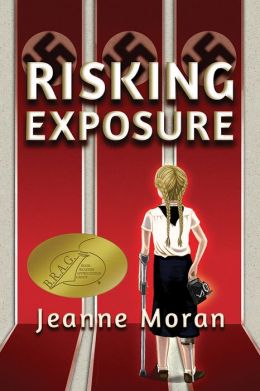Local author Jeanne Moran has just published RISKING EXPOSURE, a novel featuring fourteen-year-old Sophie: amateur photographer and member of Hitler Youth. We asked her what the writing process was like, and she answers below.

The one step which helped me the most was writing a log-line or a pitch, sometimes called a story in a sentence. Mine was "When fourteen-year old amateur photographer and Hitler Youth member Sophie Adler contracts polio, she unintentionally starts a journey from which there is no return, one that changes her status from Nazi insider to Nazi target." I taped it over my computer and referred to it every time I wrote. That sentence kept me focused on my overall plan for the novel and kept my ever-wandering imagination in check. So I learned that a writer can plan and outline, but has to be open to change during the first draft. And as we go through the editing process we have to be merciless, cutting beloved characters and carefully crafted scenes that don't advance the story.

The one step which helped me the most was writing a log-line or a pitch, sometimes called a story in a sentence. Mine was "When fourteen-year old amateur photographer and Hitler Youth member Sophie Adler contracts polio, she unintentionally starts a journey from which there is no return, one that changes her status from Nazi insider to Nazi target." I taped it over my computer and referred to it every time I wrote. That sentence kept me focused on my overall plan for the novel and kept my ever-wandering imagination in check. So I learned that a writer can plan and outline, but has to be open to change during the first draft. And as we go through the editing process we have to be merciless, cutting beloved characters and carefully crafted scenes that don't advance the story.
During
the course of researching the setting and the historical details, I read 60+
books and quite a few articles in era magazines and newspapers. I watched
dozens of documentaries including interviews with former members of Hitler
Youth. I also researched polio, the symptoms and treatment and aftermath that
so many thousands of people around the world endured. I corresponded with an
archivist at the March of Dimes (formerly called the National Polio Foundation)
and he shared a wealth of information about polio and its rehab. I contacted
the Library of Congress in Washington DC, and with a few days’ notice, they
pulled original Nazi newspapers and photographs from off-site storage and
brought them to the main library. What an amazing experience, to don white
gloves and handle the actual items from 75 years ago. I used their scanners and
my own digital camera to photograph what I needed and brought home over a hundred
images on my memory stick.
I traveled to Munich Germany (yes, I went to
Munich to research my novel!) and walked the streets where Sophie would have
lived. I figured out where she would have gone to school and to church and
walked through the English Garden Park where some key events in the novel take
place. While there I also visited the Munich city archives, where the librarian
allowed me to view 1930s city maps and photos and shared copies of them. Above
all else, the trip to Munich helped me create what I hope is an authentic feel
for the setting. I also did some less typical research. On ebay, I bought a
1938 Sears Roebuck catalog to see what products were in common use at the time.
Since Sophie is an amateur photographer, I also bought a 1930s German camera
that she might have used so I could describe its use accurately. Amazingly, I found
a video on You Tube of the actual Nazi procession which figures in the final
scene of the novel. Who knew?
Join us here at the library for an Author Talk featuring Jeanne on Tuesday, January 14 at 6:30PM. Please register.